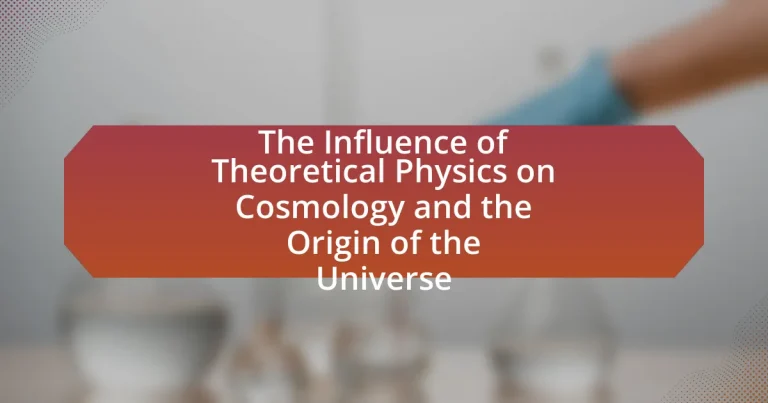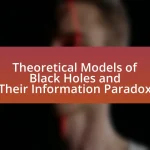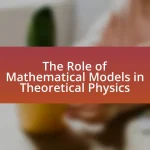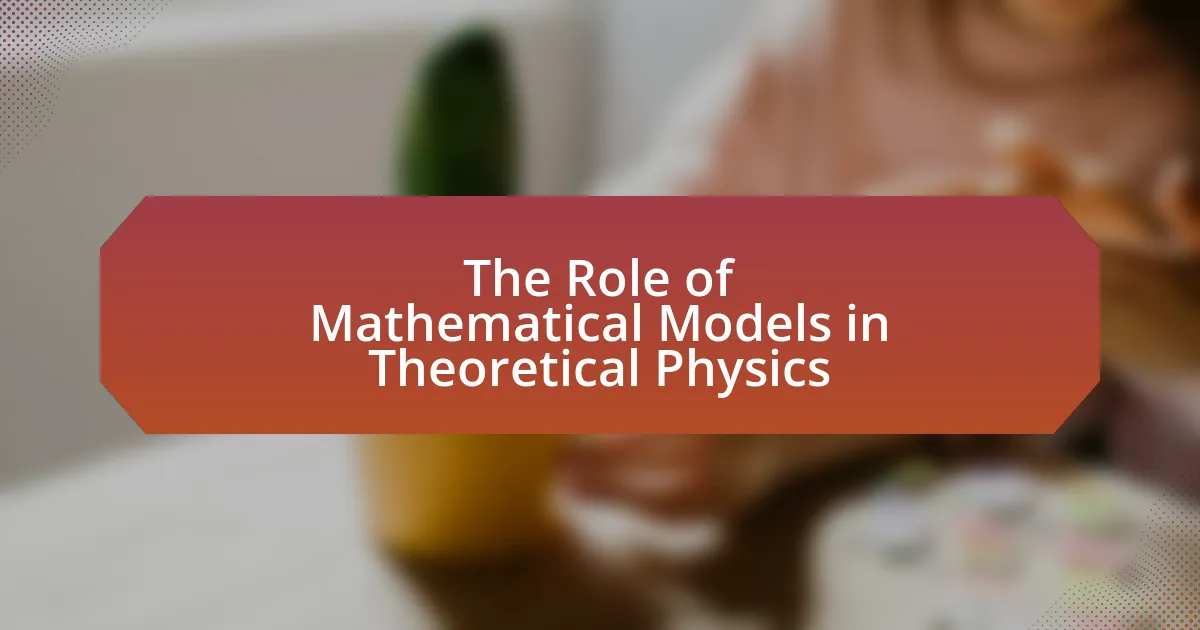The article examines the significant influence of theoretical physics on cosmology and the understanding of the universe’s origin. It highlights key theories such as general relativity and quantum mechanics, which provide essential frameworks for explaining cosmic phenomena, including the Big Bang and cosmic inflation. The interplay between these theoretical models and observational data, such as cosmic microwave background radiation, is discussed, emphasizing their role in shaping modern cosmological thought. Additionally, the article addresses unresolved questions in cosmology, the challenges of integrating quantum mechanics with general relativity, and the implications of dark matter and dark energy for existing theories.
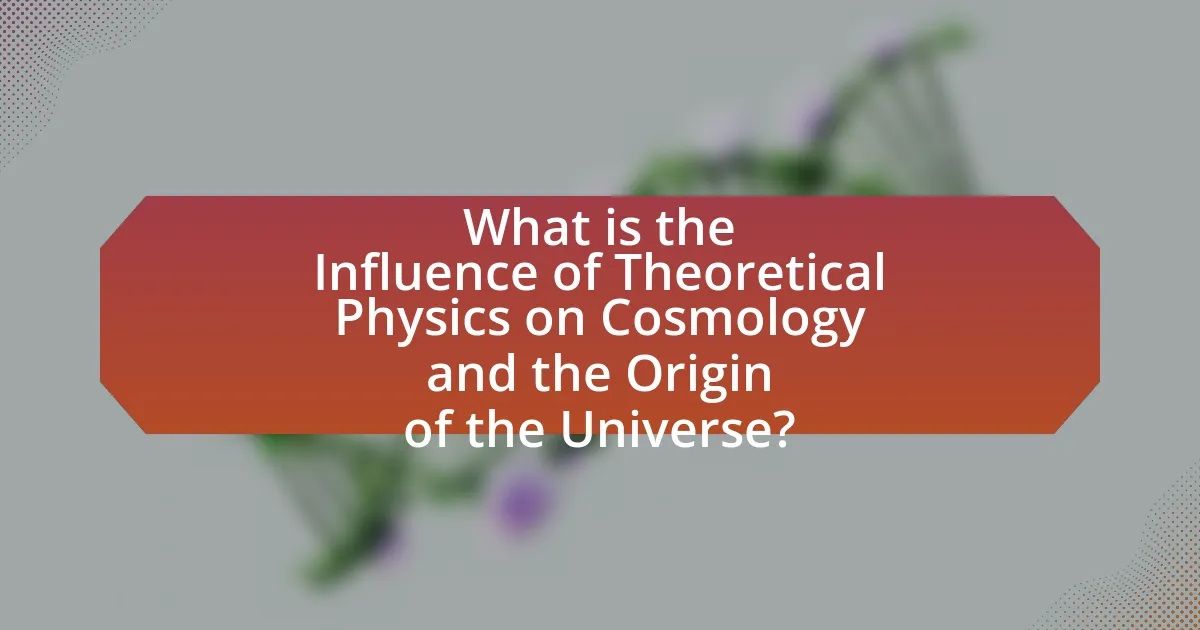
What is the Influence of Theoretical Physics on Cosmology and the Origin of the Universe?
Theoretical physics significantly influences cosmology and the understanding of the universe’s origin by providing mathematical frameworks and models that describe cosmic phenomena. For instance, the application of general relativity, formulated by Albert Einstein, allows cosmologists to understand the dynamics of spacetime and the gravitational interactions that shape the universe. This theory underpins models such as the Big Bang theory, which posits that the universe originated from a singularity approximately 13.8 billion years ago. Furthermore, quantum mechanics contributes to cosmology through concepts like quantum fluctuations, which may have played a role in the formation of cosmic structures. The interplay between these theoretical frameworks and observational data, such as cosmic microwave background radiation measurements, validates and refines our understanding of the universe’s evolution and origin.
How has theoretical physics shaped our understanding of cosmology?
Theoretical physics has fundamentally shaped our understanding of cosmology by providing the mathematical frameworks and models that describe the universe’s structure, behavior, and evolution. For instance, Einstein’s General Theory of Relativity revolutionized cosmology by introducing the concept that gravity is a curvature of spacetime, leading to predictions about the expansion of the universe and the existence of black holes. This theory laid the groundwork for the Big Bang model, which describes the universe’s origin approximately 13.8 billion years ago, supported by observational evidence such as the cosmic microwave background radiation and the redshift of distant galaxies. Additionally, quantum mechanics has contributed to cosmological theories, particularly in understanding phenomena like cosmic inflation, which explains the uniformity of the universe at large scales. These theoretical advancements have been validated through empirical observations, reinforcing their significance in shaping modern cosmological thought.
What key theories in theoretical physics are relevant to cosmology?
Key theories in theoretical physics relevant to cosmology include the Big Bang Theory, General Relativity, and Quantum Cosmology. The Big Bang Theory describes the origin of the universe as a rapid expansion from a singularity approximately 13.8 billion years ago, supported by evidence such as cosmic microwave background radiation and the observed redshift of distant galaxies. General Relativity, formulated by Albert Einstein, provides the framework for understanding gravity’s role in the structure and evolution of the universe, predicting phenomena like black holes and gravitational waves. Quantum Cosmology attempts to reconcile quantum mechanics with general relativity, exploring the universe’s behavior at the smallest scales and addressing questions about the initial conditions of the universe. These theories collectively shape our understanding of the cosmos and its origins.
How do these theories explain the origin of the universe?
Theories such as the Big Bang Theory and Quantum Cosmology explain the origin of the universe by proposing that it began from an extremely hot and dense state approximately 13.8 billion years ago. The Big Bang Theory posits that the universe expanded rapidly from this singularity, leading to the formation of matter and the cosmic microwave background radiation, which serves as evidence of this event. Quantum Cosmology introduces concepts from quantum mechanics, suggesting that fluctuations in a quantum field could have initiated the expansion, allowing for the creation of particles and the subsequent structure of the universe. Both theories are supported by observational data, including the redshift of galaxies and the uniformity of the cosmic microwave background, confirming their validity in explaining the universe’s origin.
Why is the relationship between theoretical physics and cosmology significant?
The relationship between theoretical physics and cosmology is significant because theoretical physics provides the mathematical frameworks and models necessary to understand the fundamental laws governing the universe. These frameworks, such as general relativity and quantum mechanics, enable cosmologists to describe phenomena like the Big Bang, cosmic inflation, and the expansion of the universe. For instance, general relativity, formulated by Albert Einstein, predicts the curvature of spacetime around massive objects, which is essential for understanding gravitational effects on cosmic scales. This interplay allows for the development of testable predictions about the universe’s structure and evolution, thereby advancing our knowledge of its origins and behavior.
What implications does this relationship have for our understanding of the universe?
The relationship between theoretical physics and cosmology significantly enhances our understanding of the universe by providing a framework for explaining its origins and structure. This connection allows scientists to develop models, such as the Big Bang theory, which is supported by observational evidence like cosmic microwave background radiation and the redshift of distant galaxies. These models help to elucidate fundamental concepts such as the expansion of the universe and the nature of dark matter and dark energy, which together constitute about 95% of the universe’s total mass-energy content. Thus, the interplay between theoretical physics and cosmology not only deepens our comprehension of the universe’s past but also informs predictions about its future evolution.
How does theoretical physics inform cosmological models?
Theoretical physics informs cosmological models by providing the mathematical frameworks and physical principles that describe the universe’s structure and evolution. For instance, Einstein’s General Theory of Relativity offers the foundation for understanding gravitational interactions on a cosmic scale, leading to models of the expanding universe, such as the Big Bang theory. Additionally, concepts from quantum mechanics contribute to understanding phenomena like cosmic inflation and the behavior of matter and energy in extreme conditions. These theoretical insights are validated through observational data, such as the cosmic microwave background radiation, which supports predictions made by these models.
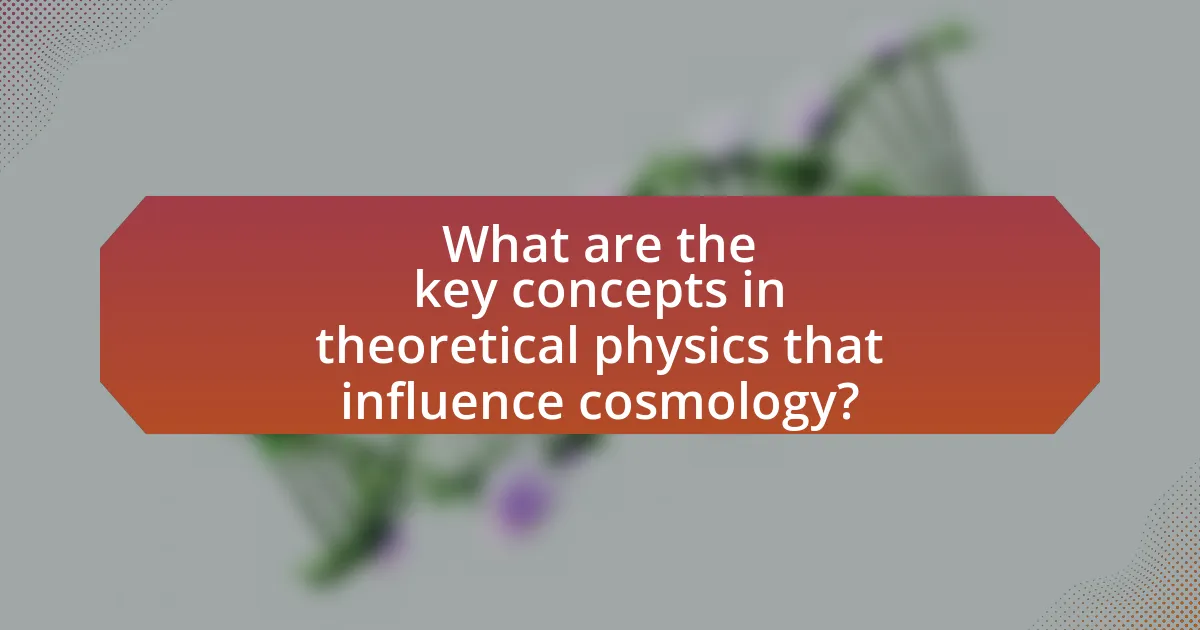
What are the key concepts in theoretical physics that influence cosmology?
Key concepts in theoretical physics that influence cosmology include general relativity, quantum mechanics, and the standard model of particle physics. General relativity, formulated by Albert Einstein, describes the gravitational interaction as the curvature of spacetime, which is fundamental for understanding the large-scale structure of the universe and phenomena such as black holes and cosmic expansion. Quantum mechanics provides insights into the behavior of particles at the smallest scales, influencing theories about the early universe and cosmic inflation. The standard model of particle physics outlines the fundamental particles and forces, which are essential for explaining the formation of elements in the universe and the interactions that govern cosmic evolution. These concepts collectively shape our understanding of the universe’s origin, structure, and ultimate fate.
What role does quantum mechanics play in cosmological theories?
Quantum mechanics plays a crucial role in cosmological theories by providing a framework for understanding the behavior of particles and fields at the smallest scales, which influences the large-scale structure of the universe. Specifically, quantum fluctuations in the early universe are thought to have seeded the formation of cosmic structures, as described in the theory of cosmic inflation proposed by Alan Guth in 1981. This theory posits that rapid expansion in the universe’s infancy was driven by quantum effects, leading to the uniformity and anisotropies observed in the cosmic microwave background radiation. Additionally, quantum mechanics underpins the principles of quantum field theory, which is essential for describing fundamental forces and particles in the context of cosmology, thereby linking the micro and macro aspects of the universe.
How does quantum mechanics contribute to our understanding of the early universe?
Quantum mechanics contributes to our understanding of the early universe by providing a framework for explaining phenomena such as cosmic inflation and the behavior of particles at extremely high energies. The theory of quantum fluctuations suggests that tiny variations in energy density during the inflationary period could lead to the large-scale structure of the universe observed today. Additionally, quantum mechanics underpins the concept of wave-particle duality, which is essential for understanding the interactions of fundamental particles in the high-energy conditions present shortly after the Big Bang. This connection is supported by the work of physicists like Alan Guth, who proposed the inflationary model, and the subsequent observations of cosmic microwave background radiation that align with predictions made by quantum theories.
What are the challenges of integrating quantum mechanics with general relativity?
The challenges of integrating quantum mechanics with general relativity primarily stem from their fundamentally different frameworks. Quantum mechanics operates on probabilistic principles and describes the behavior of particles at the smallest scales, while general relativity is a deterministic theory that describes gravity as the curvature of spacetime on a macroscopic scale. This discrepancy leads to difficulties in reconciling the two theories, particularly in extreme conditions such as black holes and the Big Bang, where both quantum effects and gravitational effects are significant.
Additionally, the lack of a unified mathematical framework that can seamlessly incorporate both theories complicates the integration process. For instance, attempts to formulate a theory of quantum gravity, such as string theory and loop quantum gravity, have yet to produce universally accepted results. These challenges highlight the ongoing quest in theoretical physics to develop a coherent model that can accurately describe the universe across all scales.
How does general relativity impact our understanding of cosmic phenomena?
General relativity fundamentally alters our understanding of cosmic phenomena by describing how massive objects warp spacetime, which influences the motion of celestial bodies. This theory explains the behavior of gravity not as a force but as a curvature of spacetime caused by mass, leading to predictions such as the bending of light around massive objects and the existence of black holes. Empirical evidence supporting general relativity includes the observation of gravitational waves, detected by LIGO in 2015, which confirmed the theory’s predictions about colliding black holes. Additionally, general relativity provides the framework for understanding the expansion of the universe, as demonstrated by the redshift of distant galaxies, which supports the Big Bang theory.
What are the implications of general relativity for the structure of the universe?
General relativity fundamentally alters our understanding of the universe’s structure by describing gravity as the curvature of spacetime caused by mass. This theory implies that massive objects, such as stars and galaxies, warp the fabric of spacetime, leading to phenomena such as gravitational lensing and the expansion of the universe. Observations of cosmic microwave background radiation and the distribution of galaxies support this framework, demonstrating that the universe is not static but dynamic, expanding over time as evidenced by Hubble’s law. Additionally, general relativity predicts the existence of black holes and the potential for singularities, which further influences the cosmic structure by suggesting regions of extreme gravitational pull that can affect surrounding matter and light.
How does general relativity explain the expansion of the universe?
General relativity explains the expansion of the universe through its description of spacetime as a dynamic entity that can stretch and curve. According to Einstein’s field equations, the presence of mass and energy influences the curvature of spacetime, leading to gravitational effects that govern the motion of celestial bodies. This framework allows for solutions that describe an expanding universe, such as the Friedmann-Lemaître-Robertson-Walker (FLRW) metric, which models a homogeneous and isotropic universe. Observational evidence, such as the redshift of distant galaxies discovered by Edwin Hubble, supports this expansion, indicating that galaxies are moving away from each other, consistent with the predictions of general relativity.
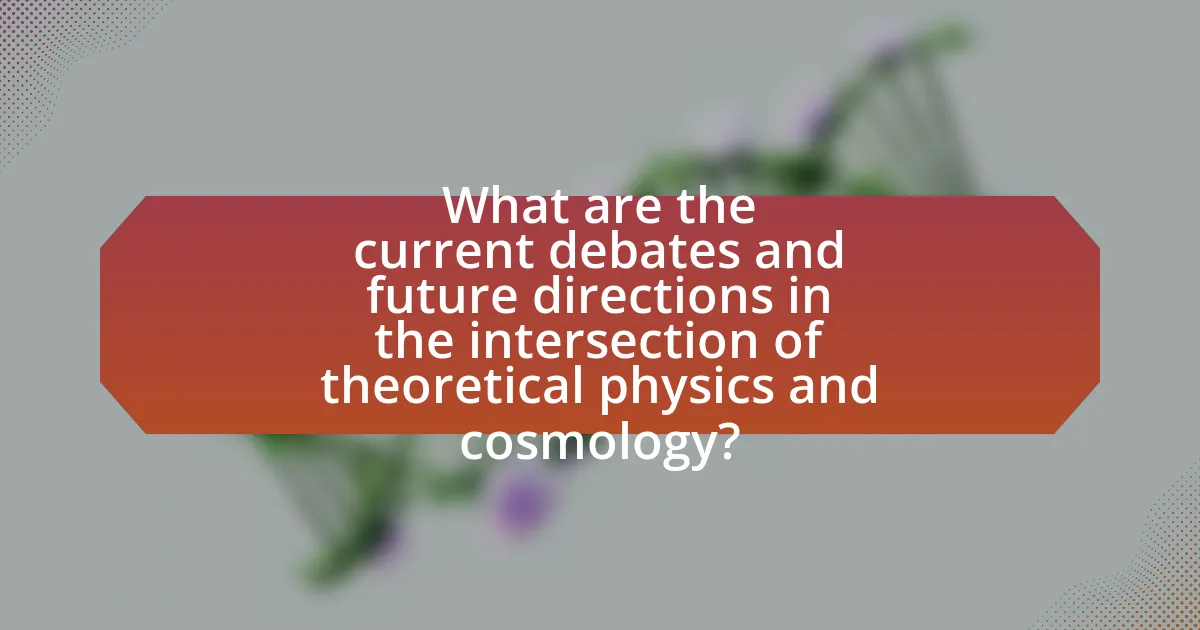
What are the current debates and future directions in the intersection of theoretical physics and cosmology?
Current debates in the intersection of theoretical physics and cosmology focus on the nature of dark matter and dark energy, the validity of quantum gravity theories, and the implications of the multiverse hypothesis. Researchers are examining whether dark matter is composed of weakly interacting massive particles (WIMPs) or alternative candidates like axions, while the role of dark energy in the universe’s accelerated expansion remains contentious. Additionally, the quest for a unified theory of quantum gravity, such as string theory or loop quantum gravity, is a significant area of exploration, as it seeks to reconcile general relativity with quantum mechanics. Future directions include the potential for observational breakthroughs from advanced telescopes and gravitational wave detectors, which may provide empirical data to support or refute existing theories. The ongoing analysis of cosmic microwave background radiation and large-scale structure surveys will also play a crucial role in shaping our understanding of the universe’s origins and fundamental laws.
What are the major unresolved questions in cosmology influenced by theoretical physics?
Major unresolved questions in cosmology influenced by theoretical physics include the nature of dark matter and dark energy, the initial conditions of the universe, the validity of inflationary theory, and the reconciliation of general relativity with quantum mechanics. Dark matter and dark energy constitute approximately 95% of the universe’s total mass-energy content, yet their fundamental properties remain unknown. The initial conditions of the universe, particularly what preceded the Big Bang, challenge current models and theories. Inflationary theory, which posits a rapid expansion of the universe, lacks definitive empirical evidence, raising questions about its accuracy. Finally, the quest to unify general relativity, which describes gravity, with quantum mechanics, which governs subatomic particles, remains one of the most significant challenges in theoretical physics and cosmology.
How do dark matter and dark energy challenge existing theories?
Dark matter and dark energy challenge existing theories by introducing components of the universe that cannot be directly observed yet constitute approximately 95% of its total mass-energy content. The presence of dark matter, which does not emit light or energy, contradicts the predictions of the standard model of particle physics, as it suggests the existence of unknown particles that interact through gravity but not electromagnetically. Similarly, dark energy, responsible for the accelerated expansion of the universe, defies classical gravitational theories, which assume that gravity should slow down cosmic expansion. Observations, such as those from the Cosmic Microwave Background and galaxy cluster dynamics, provide evidence for these phenomena, highlighting discrepancies between theoretical predictions and empirical data, thus necessitating revisions to our understanding of fundamental physics and cosmology.
What role does string theory play in addressing these unresolved questions?
String theory plays a crucial role in addressing unresolved questions in theoretical physics and cosmology by providing a framework that unifies the fundamental forces of nature and incorporates quantum mechanics. This theoretical framework suggests that the basic building blocks of the universe are not point-like particles but rather one-dimensional strings, which can vibrate at different frequencies to manifest as various particles.
String theory offers potential solutions to issues such as the nature of black holes, the unification of gravity with quantum mechanics, and the behavior of the universe at the Planck scale. For instance, it proposes mechanisms for resolving singularities in black holes and the Big Bang, which are significant challenges in current cosmological models. Additionally, string theory has led to the development of concepts like the multiverse, which attempts to explain the fine-tuning of physical constants observed in our universe.
The validity of string theory is supported by its mathematical consistency and its ability to produce results that align with experimental observations, such as the prediction of certain particle behaviors in high-energy physics. However, it remains a subject of ongoing research, as direct experimental evidence for string theory is still lacking.
How can advancements in theoretical physics lead to new discoveries in cosmology?
Advancements in theoretical physics can lead to new discoveries in cosmology by providing frameworks that explain complex phenomena and predict new cosmic events. For instance, the development of string theory has the potential to unify general relativity and quantum mechanics, offering insights into the early universe and black hole behavior. Additionally, advancements in quantum field theory have led to the prediction of cosmic inflation, which explains the uniformity of the cosmic microwave background radiation. These theoretical models are validated through observational data, such as measurements from the Planck satellite, which supports the inflationary model and enhances our understanding of the universe’s expansion.
What technologies are emerging from theoretical physics research that could impact cosmology?
Emerging technologies from theoretical physics research that could impact cosmology include quantum computing, advanced gravitational wave detectors, and high-energy particle accelerators. Quantum computing enables complex simulations of cosmic phenomena, potentially leading to new insights into dark matter and dark energy. Advanced gravitational wave detectors, such as LIGO and Virgo, enhance our ability to observe cosmic events, providing data that can refine cosmological models. High-energy particle accelerators, like the Large Hadron Collider, allow researchers to explore fundamental particles and forces, which can inform our understanding of the universe’s origins and structure. These technologies collectively advance our knowledge of cosmology by offering new methods to test theories and gather empirical data.
How can interdisciplinary approaches enhance our understanding of the universe’s origin?
Interdisciplinary approaches enhance our understanding of the universe’s origin by integrating insights from various fields such as physics, astronomy, philosophy, and mathematics. This integration allows for a more comprehensive analysis of complex phenomena, such as the Big Bang and cosmic inflation, by combining theoretical models with observational data. For instance, physicists use mathematical frameworks to predict cosmic events, while astronomers provide empirical evidence through telescopic observations. The collaboration between these disciplines has led to significant advancements, such as the detection of cosmic microwave background radiation, which supports the Big Bang theory. By fostering dialogue among diverse fields, interdisciplinary approaches facilitate innovative methodologies and enhance the depth of inquiry into the fundamental questions surrounding the universe’s origin.
What practical insights can we gain from the influence of theoretical physics on cosmology?
The influence of theoretical physics on cosmology provides practical insights into the fundamental nature of the universe, including the behavior of cosmic structures and the origins of cosmic phenomena. For instance, theories such as general relativity have led to the understanding of black holes and the expansion of the universe, which are critical for interpreting astronomical observations. Additionally, the application of quantum mechanics in cosmology has resulted in insights into the early universe, particularly through models like cosmic inflation, which explains the uniformity of the cosmic microwave background radiation. These theoretical frameworks have been validated through empirical evidence, such as the detection of gravitational waves and the precise measurements of cosmic background radiation by missions like the Planck satellite, reinforcing the connection between theoretical predictions and observable phenomena in cosmology.
